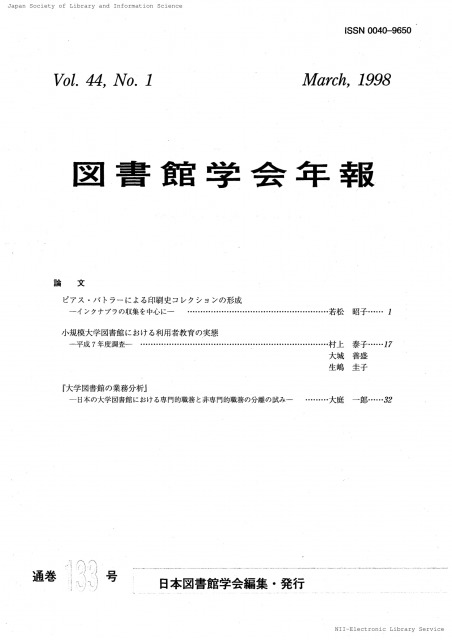All issues

Volume 29 (1983)
- Issue 4 Pages 145-
- Issue 3 Pages 97-
- Issue 2 Pages 49-
- Issue 1 Pages 1-
- Issue Supplement Page・・・
Volume 29, Issue 4
Displaying 1-9 of 9 articles from this issue
- |<
- <
- 1
- >
- >|
-
[in Japanese]1983 Volume 29 Issue 4 Pages 145-166
Published: 1983
Released on J-STAGE: October 07, 2022
JOURNAL FREE ACCESSDownload PDF (2887K) -
Koji OGURO1983 Volume 29 Issue 4 Pages 167-180
Published: 1983
Released on J-STAGE: October 07, 2022
JOURNAL FREE ACCESSDuring the earlier modern age (近世) of China which opened with the establishment of the Northern Sung dynasty, the library service made a great progress. This author discusses now the Imperial Library functioned at the beginning of the dynasty and how its functions changed afterwards.
Part one eraluates the important role the Library played at the very time of the political centralization of the Sung dynasty. The main functions of the Libraries collecting and editing of books in accordance with the policy of civilian control of that dynasty.
The objectives of these literary services are:
1. To win the confidence the people
2. To be informed with the conditions of the country
3. To have control over the thoughts
4. To strengthen the political organization of the state.
Part two discribes the process of historical development of the organizations and functions of the libraries during the advancement of the national rule by the dynasty. At first, the library system was composed of Chao Wen Kuan (昭文鎗), Chi Hsien Yüan (集賢院), and Shih Kuan (史館), which were known as Three Libraies (三館 San-Kuan), later as Tsung Wen Yüan (崇文院). Shih Kuan was the center of the three. This system may have originated in the chaotic time of Wu-tai (五代).
PiKo (祕閣) was founded in Tsung Wen Yüan. It took place of Shih Kuan, and these all were called Kuan-Ko (館閣), which formed the whole library system of this dynasty.View full abstractDownload PDF (1858K)
-
[in Japanese]1983 Volume 29 Issue 4 Pages 181-184
Published: 1983
Released on J-STAGE: October 07, 2022
JOURNAL FREE ACCESSDownload PDF (572K)
-
[in Japanese]1983 Volume 29 Issue 4 Pages 189-190
Published: 1983
Released on J-STAGE: October 07, 2022
JOURNAL FREE ACCESSDownload PDF (275K)
-
1983 Volume 29 Issue 4 Pages 184
Published: 1983
Released on J-STAGE: October 07, 2022
JOURNAL FREE ACCESSDownload PDF (130K) -
1983 Volume 29 Issue 4 Pages 185-187
Published: 1983
Released on J-STAGE: October 07, 2022
JOURNAL FREE ACCESSDownload PDF (274K) -
[in Japanese]1983 Volume 29 Issue 4 Pages 188
Published: 1983
Released on J-STAGE: October 07, 2022
JOURNAL FREE ACCESSDownload PDF (305K) -
1983 Volume 29 Issue 4 Pages 190,192
Published: 1983
Released on J-STAGE: October 07, 2022
JOURNAL FREE ACCESSDownload PDF (225K)
Summary
-
Article type: Summary
1983 Volume 29 Issue 4 Pages 191-192
Published: 1983
Released on J-STAGE: October 07, 2022
JOURNAL FREE ACCESSDownload PDF (173K)
- |<
- <
- 1
- >
- >|